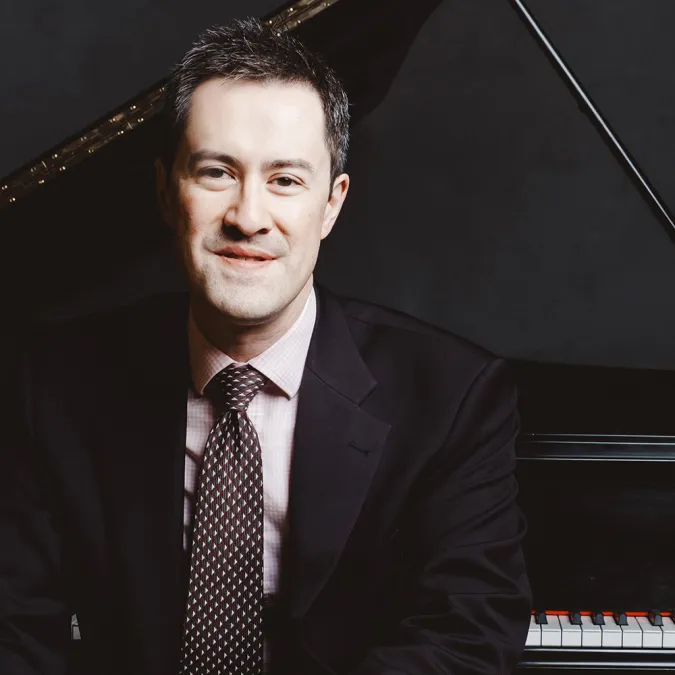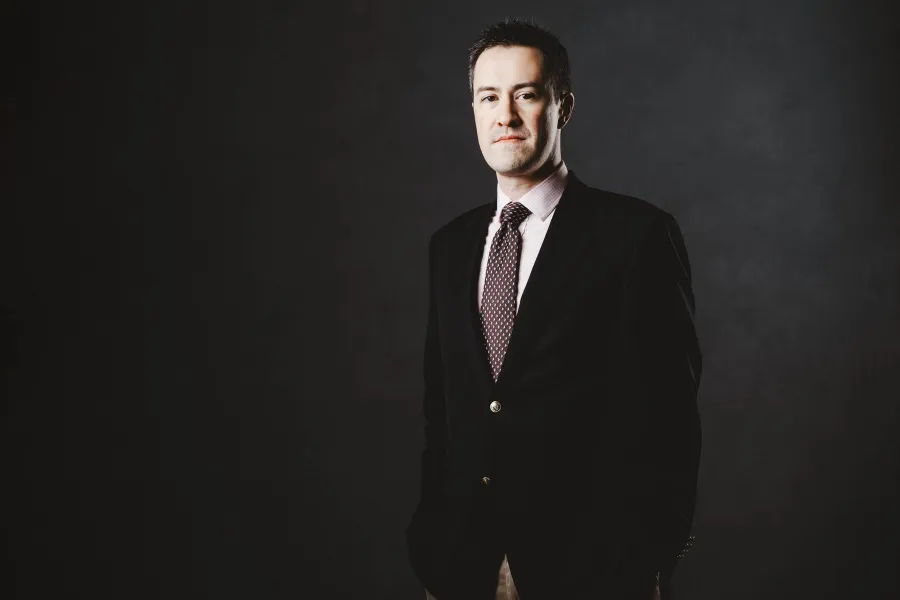This concert will last about 80 minutes with a 10-minute intermission.
Please silence your electronic devices
Photography, video, or recording of any part of this performance is prohibited
Program
W.A. Mozart
Sonata in A Major, K. 331
Andante grazioso con variazioni
Menuetto
Alla turca. Allegrino
Antonín Dvořák
Selections from Poetic Tone Pictures, op. 85
Noční cestou (Nighttime Journey)
Na starém hradě (In the Old Castle)
Furiant
Bacchanalia
Na svaté hoře (On the Holy Mountain)
intermission
Johann Pachelbel
Chaconne in F Minor, P. 43
Frédéric Chopin
Nocturne in A-flat Major, op. 32 no. 2
Scherzo No. 4 in E Major, op. 54
About the Program
Program notes by Mark Bilyeu
Wolfgang Amadeus Mozart
Piano Sonata No. 11 in A Major. K. 331
Born January 27, 1756 in Salzburg, Austria
Died December 5, 1791 in Vienna, Austria
Composed 1783
Duration 22 minutes
For over two hundred years, we believed Mozart wrote his eleventh piano sonata in Paris in 1778. But in September of 2014, inside the music department of the Széchényi National Library in Budapest, a leaflet with Mozart’s own notation of parts of this sonata was discovered. Thrilling not only for the sheer shock value of stumbling upon Mozart’s handwriting, the discovery showed some considerable differences in what scholars had told us were the right notes, rhythms, and dynamics for these past two centuries. It also showed that Mozart had written this work nearly five years earlier, in 1773. A musicologist’s actual dream. Regardless of tempo changes and dynamic alterations, one thing is certain: you have already heard this piano sonata; or, at least its final movement: the famous Rondo alla Turca, or the Turkish March. Mozart, like so many, was obsessed with music from distant lands, and so when the Ottoman Empire began spreading throughout the land, a pleasant result for musicians was the ubiquitous nature of the Turkish Janissary bands, as they blasted their military marches from town to town. With our updated timeline, we now know that Mozart was going through what we might call a “Turkish phase,” as his singspiel “Abduction from the Seraglio” (an operetta which deals in tropes of Turkish culture) had premiered just one year earlier, in 1782. The sonata opens with a set of variations, and the second movement is a lovely minuet leading to one of the most recognizable piano works of all time.
Antonín Dvořák
Selections from Poetic Tone Pictures, op. 85
Born September 8, 1841 Nelahozeves, Bohemia
Died May 1, 1904, Bohemia
Composed 1889
Published 1889
On May 19, 1889, Antonín Dvořák wrote to his publisher saying “...in the near future I will have finished something for piano solo (two hands) … It will be twelve pieces in length, that is, two (if not three) volumes, as some of the pieces are relatively long. Each piece will bear a title and is intended to express something, i. e. it is to a certain extent programme music, but in Schumann’s sense of the term; and yet I must remark forthwith that they do not sound Schumannesque.” Dvořák’s goal in writing these was, in fact, to please his publisher. Simrock — the publisher responsible for nearly the entire catalogue of Brahms - was not simply a musical advocate; he was first a business man, and he knew what the public wanted: short, accessible works that exceptional amateurs would buy to learn to play for their friends, who would then go out and buy the same music to learn and play for their friends. Capitalism. The complete work ended up with thirteen pieces, which — we read above — Dvořák believed could be published in three volumes (again: appealing to Simrock the businessman). Brahms believed he should be awarded 3,000, but Simrock argued for a lesser amount, writing “Your ‘piano pieces’ please me quite well, but I do not believe that they are very accessible musically or that they will become what is called ‘popular’! Several of the numbers, however, even give me quite a bit of pleasure! Indeed, I love your music altogether, my dear friend, but unfortunately I am not the public at large!!” The works have since proven Simrock very incorrect. Each of the movements is a study in sound and color, ranging from Czech-Bohemian folk music to comic miniatures and from idyllic pastorales to religious chants. “This time, I am not only an absolute musician,” wrote the composer, “but also a poet.”
Johann Pachelbel
Chaconne in F Minor, p. 43
Baptized Sept 11, 1653, Nuremberg, Germany
Buried March 9, 1706, Nuremberg, Germany
Duration 14 minutes
Unlike many composers of his time, Johann Pachelbel had much of his music published during his lifetime, and enjoyed much notoriety and success because of it. Born in Nuremberg to a middle-class family, Pachelbel traveled for his schooling, and after postings in Vienna and Eisenach, landed a job at the Lutheran Predigerkirche in Erfurt, Germany. It was in Erfurt where he solidified his professional reputation and where he also met his wife, Barbara Gabler, the daughter of the mayor of Erfurt. They married in 1681, but in 1683, both Barbara and their newborn son died, likely due to the plague. Pachelbel’s first publication, Musikalische Sterbens-Gedancken (Musical Thoughts on Death), was published that same year. Although his Chaconne in F Minor (an undated work, originally for organ) is not taken from this collection, many believe it was also written in response to the composer’s grief. The 18th century musicologist Christian Schubart wrote that for many composers, F minor was a key of "deep depression, funereal lament, groans of misery and longing for the grave." The form of a chaconne features melodic variations above a ground bass (a repeated set of notes in the lower voice), not entirely dissimilar from a canon (if you’ve been to a wedding in the past fifty years, you’re likely to have also heard a certain canon by Pachelbel). This chaconne features 22 variations over that ground bass; Pachelbel pushed the envelope when it came to texture: listen for the contrast of sparseness and density, and revel in the moods from urgency to near-apathy. Careful! If you’re not focusing too closely, you might think this rumination on a four-note ground bass was Phillip Glass.
Frédéric Chopin
Nocturne In A-flat Major, op. 32, no. 2
Born March 1, 1810, Żelazowa Wola, Poland
Died October 17, 1849, Paris, France
Composed 1837
Duration 7 minutes
Chopin wrote a total of twenty-one nocturnes for solo piano between the ages of 17 and 36. He was influenced greatly by the Irish composer John Field, who, at thirty years Chopin’s senior, had composed a total of eighteen nocturnes, and was widely known to be the inventor of the genre. As a youth, Chopin was often told he reminded people of Field - which he loved - as time went on, people began telling Field that he was “Chopinesque,” which he did not like (Field actually met Chopin in 1832, and is said to have described Chopin as a "sickroom talent”). Although Chopin’s op. 32 set of two nocturnes was not nearly as well-received as some of his other offerings, this nocturne in A-flat is a prime example of Chopin’s mastery of an art form that Field created. We are indebted to both artists.
Frédéric Chopin
Scherzo No. 4 in E Major, op. 54
Composed 1842-1843
Duration 11 minutes
This scherzo, the last of the four Chopin would write, was composed during a rather happy time for the composer: He had spent the summer of 1824 on retreat in Nohant, and although his complex relationship with George Sand remained...complex, their affection for each other rarely wavered, and seemed content. One could make this argument (if one were to paint with a wildly large brush) by simply observing the trajectory of these four scherzi. This fourth scherzo is the only one in a major key — the bright, brilliant, and sunny key of E major, in fact - and from the outset of the work, we are met with a sort of impish theme that seems to bumble along and then scamper away. But, don’t try to ascribe a narrative to the work (leave those hypotheses for Chopin’s Ballades); instead, sit back and enjoy the juxtaposition of sheer virtuosity which bookends a sublimely melancholic inner theme. The work concludes with a dazzling coda complete with thundering octaves and dizzying scales which seem to scream “joie de vivre!”
About the Artist
Andrew Brownell

Andrew Brownell is a laureate of several major international competitions, having won 2nd Prize at the 2006 Leeds Competition, 2nd Prize ex aequo at the 2002 International J. S. Bach Competition (Leipzig), and 1st Prize at the 2005 J.N. Hummel Competition (Bratislava). Mr. Brownell’s performances have aired on BBC radio and television, Classic FM (UK), NPR, CBC, Mitteldeutscher Rundfunk, and RBB KulturRadio. His teachers have included Nancy Weems and Horacio Gutiérrez at the University of Houston, John Perry at the University of Southern California, and Joan Havill at the Guildhall School of Music in London. An enthusiastic collaborative artist, Andrew Brownell has performed with principals of orchestras such as the Philharmonia, Amsterdam Concertgebouw, and Vienna Philharmonic. He was made a Fellow of the Royal College of Organists in 2010.
Upcoming Events
TRIPLE CORTADO
Album Release Concert
Tuesday, October 14, 2025, 7:30 p.m.
Bates Recital Hall
SYMPHONY ORCHESTRA
Wednesday, October 15, 2025, 7:30 p.m.
Bates Recital Hall
WILHELM MAGNER, VIOLA | JONATHAN GUNN, CLARINET | PATTI WOLF, PIANO
Monday, October 20, 2025, 7:30 p.m.
Bates Recital Hall
EBONEE THOMAS, FLUTE | WILHELM MAGNER, VIOLA | EMILY LEVIN, HARP
Monday, October 27, 2025, 7:30 p.m.
Bates Recital Hall
SCHUBERTIADE
With Anton Nel & Friends
Monday, November 3, 2025, 7:30 p.m.
Bates Recital Hall
Event Details
$10 – 20
All University of Texas at Austin students are allowed one free ticket as long as they are available. Student tickets must be picked up at the Box Office with valid student I.D. Seating is unassigned.
If you are a patron with specific seating needs, please email tickets@mail.music.utexas.edu and we will reserve ADA seating for you.


